fuel cap TOYOTA CAMRY HYBRID 2018 Owners Manual (in English)
[x] Cancel search | Manufacturer: TOYOTA, Model Year: 2018, Model line: CAMRY HYBRID, Model: TOYOTA CAMRY HYBRID 2018Pages: 596, PDF Size: 10.25 MB
Page 3 of 596
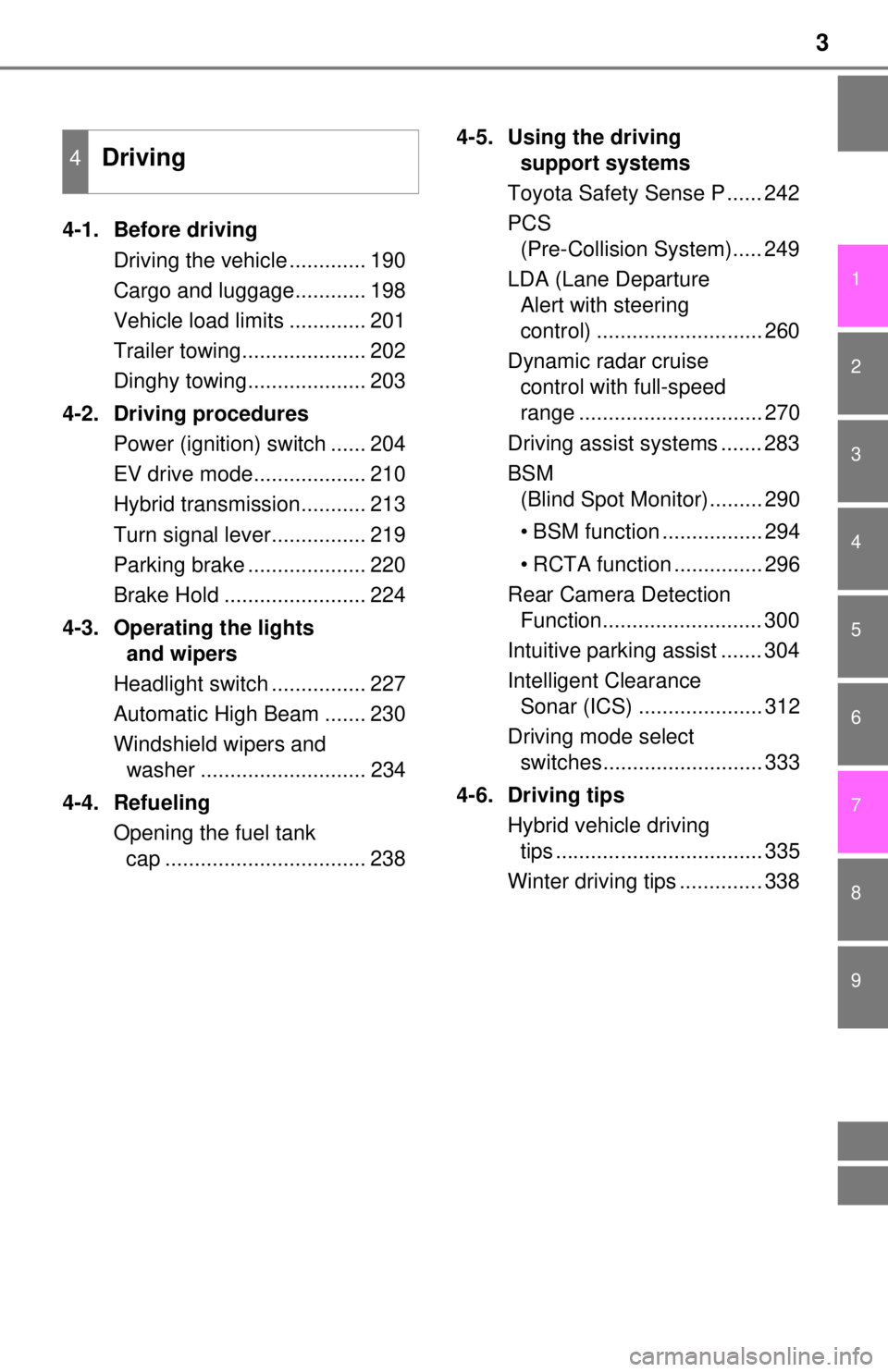
3
1
9 7 6
5
4
3
2
8
4-1. Before drivingDriving the vehicle ............. 190
Cargo and luggage............ 198
Vehicle load limits ............. 201
Trailer towing..................... 202
Dinghy towing.................... 203
4-2. Driving procedures Power (ignition) switch ...... 204
EV drive mode................... 210
Hybrid transmission........... 213
Turn signal lever................ 219
Parking brake .................... 220
Brake Hold ........................ 224
4-3. Operating the lights and wipers
Headlight switch ................ 227
Automatic High Beam ....... 230
Windshield wipers and washer ............................ 234
4-4. Refueling Opening the fuel tank cap .................................. 238 4-5. Using the driving
support systems
Toyota Safety Sense P ...... 242
PCS (Pre-Collision System)..... 249
LDA (Lane Departure Alert with steering
control) ............................ 260
Dynamic radar cruise control with full-speed
range ............................... 270
Driving assist systems ....... 283
BSM (Blind Spot Monitor)......... 290
• BSM function ................. 294
• RCTA function ............... 296
Rear Camera Detection Function........................... 300
Intuitive parking assist ....... 304
Intelligent Clearance Sonar (ICS) ..................... 312
Driving mode select switches........................... 333
4-6. Driving tips Hybrid vehicle driving tips ................................... 335
Winter driving tips .............. 338
4Driving
Page 15 of 596
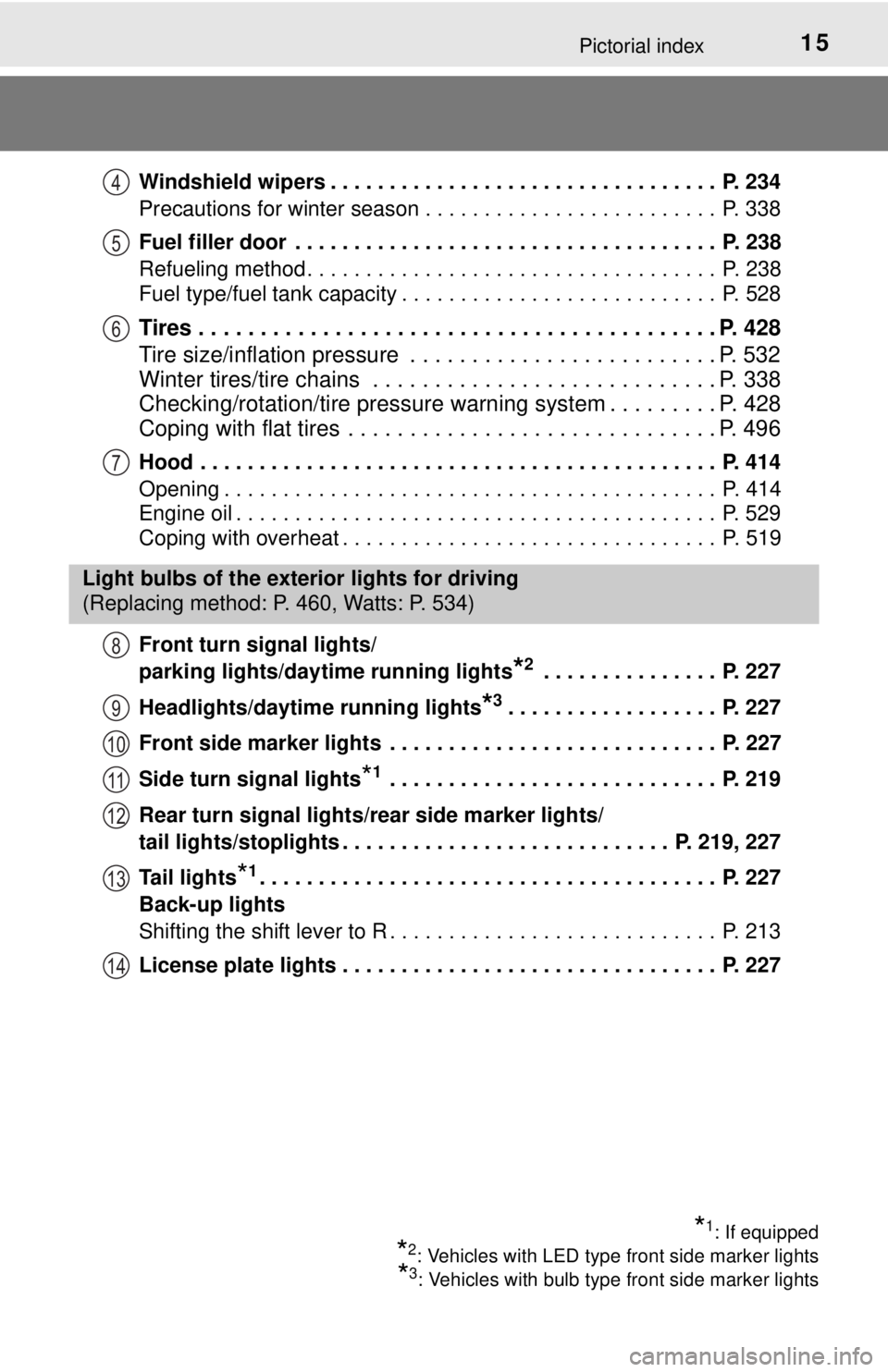
15Pictorial index
Windshield wipers . . . . . . . . . . . . . . . . . . . . . . . . . . . . . . . . . P. 234
Precautions for winter season . . . . . . . . . . . . . . . . . . . . . . . . . P. 338
Fuel filler door . . . . . . . . . . . . . . . . . . . . . . . . . . . . . . . . . . . . P. 238
Refueling method . . . . . . . . . . . . . . . . . . . . . . . . . . . . . . . . . . . P. 238
Fuel type/fuel tank capacity . . . . . . . . . . . . . . . . . . . . . . . . . . . P. 528
Tires . . . . . . . . . . . . . . . . . . . . . . . . . . . . . . . . . . . . . . . . . . P. 428
Tire size/inflation pressure . . . . . . . . . . . . . . . . . . . . . . . . . P. 532
Winter tires/tire chains . . . . . . . . . . . . . . . . . . . . . . . . . . . . P. 338
Checking/rotation/tire pressure warning system . . . . . . . . . P. 428
Coping with flat tires . . . . . . . . . . . . . . . . . . . . . . . . . . . . . . P. 496
Hood . . . . . . . . . . . . . . . . . . . . . . . . . . . . . . . . . . . . . . . . . . . . P. 414
Opening . . . . . . . . . . . . . . . . . . . . . . . . . . . . . . . . . . . . . . . . . . P. 414
Engine oil . . . . . . . . . . . . . . . . . . . . . . . . . . . . . . . . . . . . . . . . . P. 529
Coping with overheat . . . . . . . . . . . . . . . . . . . . . . . . . . . . . . . . P. 519
Front turn signal lights/
parking lights/daytime running lights
*2 . . . . . . . . . . . . . . . P. 227
Headlights/daytime running lights
*3. . . . . . . . . . . . . . . . . . P. 227
Front side marker lights . . . . . . . . . . . . . . . . . . . . . . . . . . . . P. 227
Side turn signal lights
*1 . . . . . . . . . . . . . . . . . . . . . . . . . . . . P. 219
Rear turn signal lights/r ear side marker lights/
tail lights/stoplights . . . . . . . . . . . . . . . . . . . . . . . . . . . . P. 219, 227
Tail lights
*1. . . . . . . . . . . . . . . . . . . . . . . . . . . . . . . . . . . . . . . P. 227
Back-up lights
Shifting the shift lever to R . . . . . . . . . . . . . . . . . . . . . . . . . . . . P. 213
License plate lights . . . . . . . . . . . . . . . . . . . . . . . . . . . . . . . . P. 227
4
5
6
7
Light bulbs of the exterior lights for driving
(Replacing method: P. 460, Watts: P. 534)
*1: If equipped
*2: Vehicles with LED type front side marker lights
*3: Vehicles with bulb type front side marker lights
8
9
10
11
12
13
14
Page 189 of 596

189
4Driving
4-1. Before drivingDriving the vehicle ............. 190
Cargo and luggage ........... 198
Vehicle load limits ............. 201
Trailer towing..................... 202
Dinghy towing ................... 203
4-2. Driving procedures Power (ignition) switch ...... 204
EV drive mode .................. 210
Hybrid transmission........... 213
Turn signal lever................ 219
Parking brake .................... 220
Brake Hold ........................ 224
4-3. Operating the lights and wipers
Headlight switch ................ 227
Automatic High Beam ....... 230
Windshield wipers and washer ............................ 234 4-4. Refueling
Opening the fuel tank cap .................................. 238
4-5. Using the driving support systems
Toyota Safety Sense P ..... 242
PCS (Pre-Collision System) .... 249
LDA (Lane Departure Alert with steering control) ....... 260
Dynamic radar cruise control with full-speed
range............................... 270
Driving assist systems ...... 283
BSM (Blind Spot Monitor) ........ 290
• BSM function ................ 294
• RCTA function .............. 296
Rear Camera Detection Function .......................... 300
Intuitive parking assist....... 304
Intelligent Clearance Sonar (ICS) ..................... 312
Driving mode select switches .......................... 333
4-6. Driving tips Hybrid vehicle driving tips .................................. 335
Winter driving tips ............. 338
Page 192 of 596

1924-1. Before driving
■Restraining sudden star t (Drive-Start Control)
● When the following unusual operation is performed, the hybrid system out-
put may be restrained.
• When the shift lever is shifted from R to D, D to R, N to R, P to D, or P to
R (D includes S) with the accelerator pedal depressed, a warning mes-
sage appears on the multi-information display.
• When the accelerator pedal is depressed too much while the vehicle is in
reverse.
● While Drive-Start Control is being activated, your vehicle may have trouble
escaping from the mud or fresh snow. In such case, deactivate TRAC ( →P.
284) to cancel Drive-Start Control so that the vehicle may become able to
escape from the mud or fresh snow.
■ Breaking in your new Toyota
To extend the life of the vehicle, observing the following precautions is recom-
mended:
●For the first 186 miles (300 km):
Avoid sudden stops.
● For the first 621 miles (1000 km):
• Do not drive at extremely high speeds.
• Avoid sudden acceleration.
• Do not drive continuously in low gears.
• Do not drive at a constant speed for extended periods.
■ Operating your vehicle in a foreign country
Comply with the relevant vehicle registration laws and confirm the availability
of the correct fuel. ( →P. 528)
■ Eco-friendly driving
→P. 115, 129
Page 238 of 596
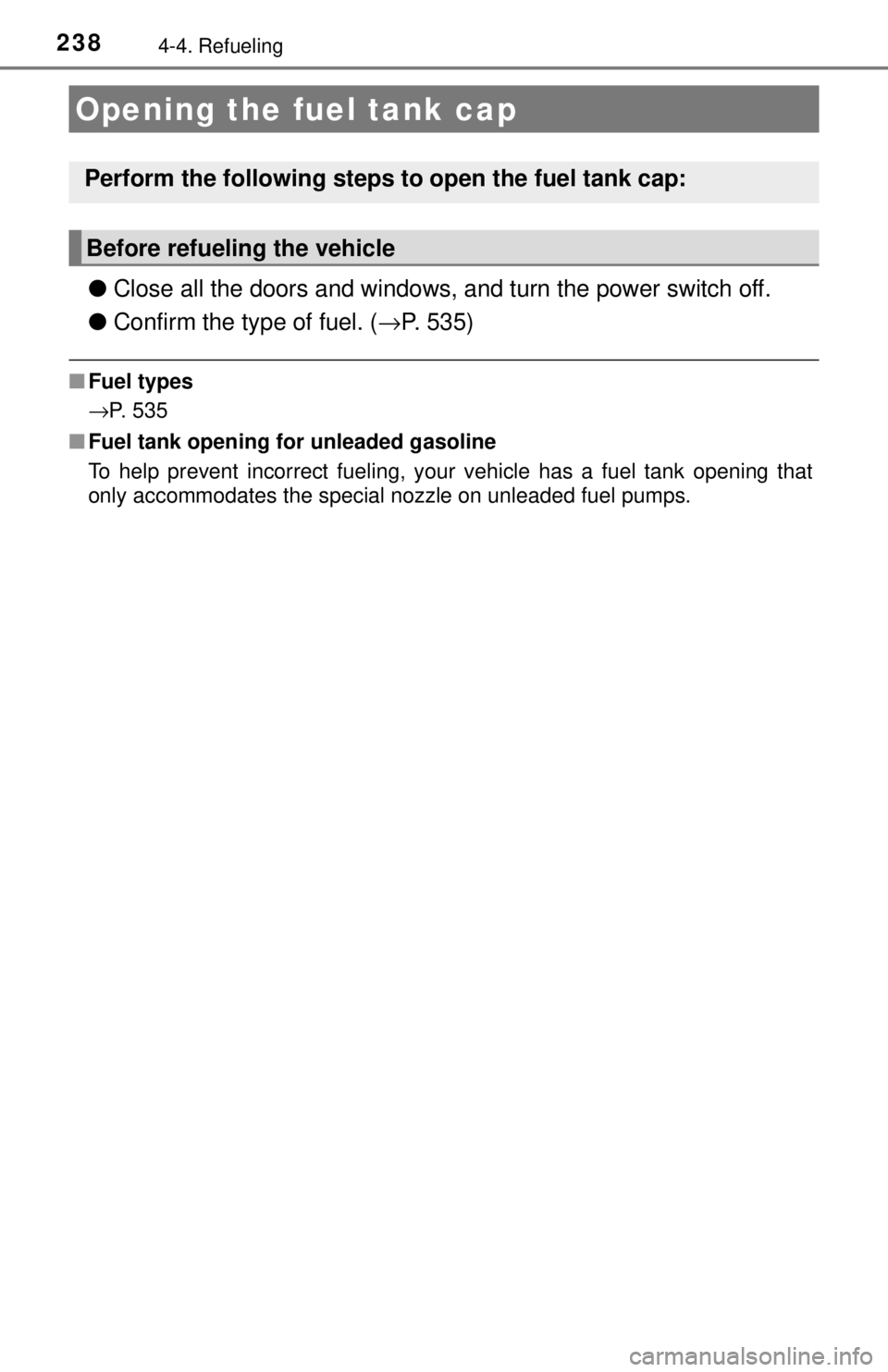
2384-4. Refueling
●Close all the doors and windows, and turn the power switch off.
● Confirm the type of fuel. ( →P. 535)
■Fuel types
→P. 535
■ Fuel tank opening for unleaded gasoline
To help prevent incorrect fueling, y our vehicle has a fuel tank opening that
only accommodates the special nozzle on unleaded fuel pumps.
Opening the fuel tank cap
Perform the following steps to open the fuel tank cap:
Before refueling the vehicle
Page 239 of 596
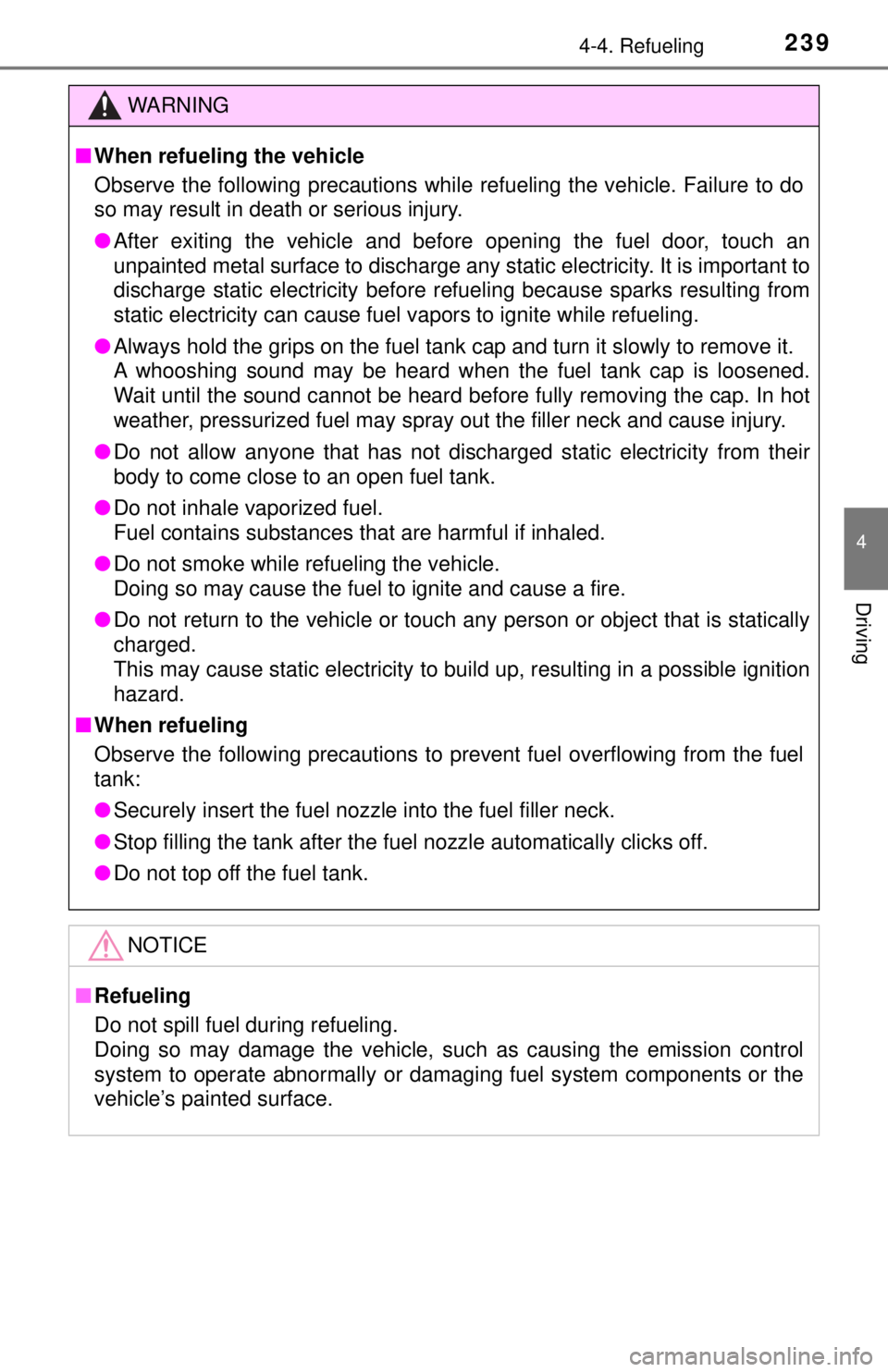
2394-4. Refueling
4
Driving
WARNING
■When refueling the vehicle
Observe the following precautions while refueling the vehicle. Failure to do
so may result in death or serious injury.
● After exiting the vehicle and before opening the fuel door, touch an
unpainted metal surface to discharge any static electricity. It is important to
discharge static electricity before refueling because sparks resulting from
static electricity can cause fuel vapors to ignite while refueling.
● Always hold the grips on the fuel tank cap and turn it slowly to remove it.
A whooshing sound may be heard when the fuel tank cap is loosened.
Wait until the sound cannot be heard before fully removing the cap. In hot
weather, pressurized fuel may spray out the filler neck and cause injury.
● Do not allow anyone that has not discharged static electricity from their
body to come close to an open fuel tank.
● Do not inhale vaporized fuel.
Fuel contains substances that are harmful if inhaled.
● Do not smoke while refueling the vehicle.
Doing so may cause the fuel to ignite and cause a fire.
● Do not return to the vehicle or touch any person or object that is statically
charged.
This may cause static electricity to build up, resulting in a possible ignition
hazard.
■ When refueling
Observe the following precautions to prevent fuel overflowing from the fuel
tank:
● Securely insert the fuel nozzle into the fuel filler neck.
● Stop filling the tank after the fuel nozzle automatically clicks off.
● Do not top off the fuel tank.
NOTICE
■Refueling
Do not spill fuel during refueling.
Doing so may damage the vehicle, such as causing the emission control
system to operate abnormally or damaging fuel system components or the
vehicle’s painted surface.
Page 240 of 596
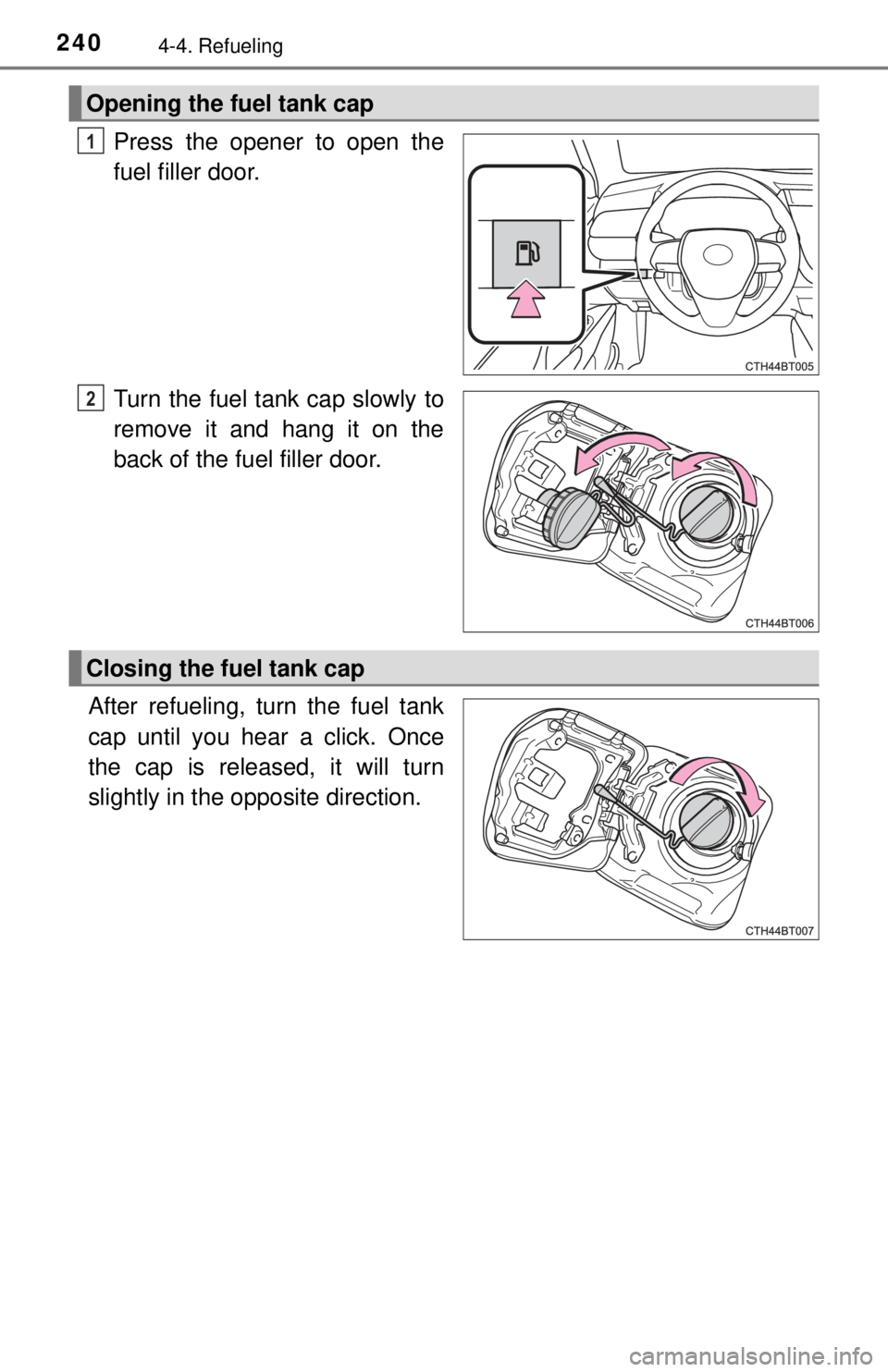
2404-4. Refueling
Press the opener to open the
fuel filler door.
Turn the fuel tank cap slowly to
remove it and hang it on the
back of the fuel filler door.
After refueling, turn the fuel tank
cap until you hear a click. Once
the cap is released, it will turn
slightly in the opposite direction.
Opening the fuel tank cap
1
2
Closing the fuel tank cap
Page 241 of 596
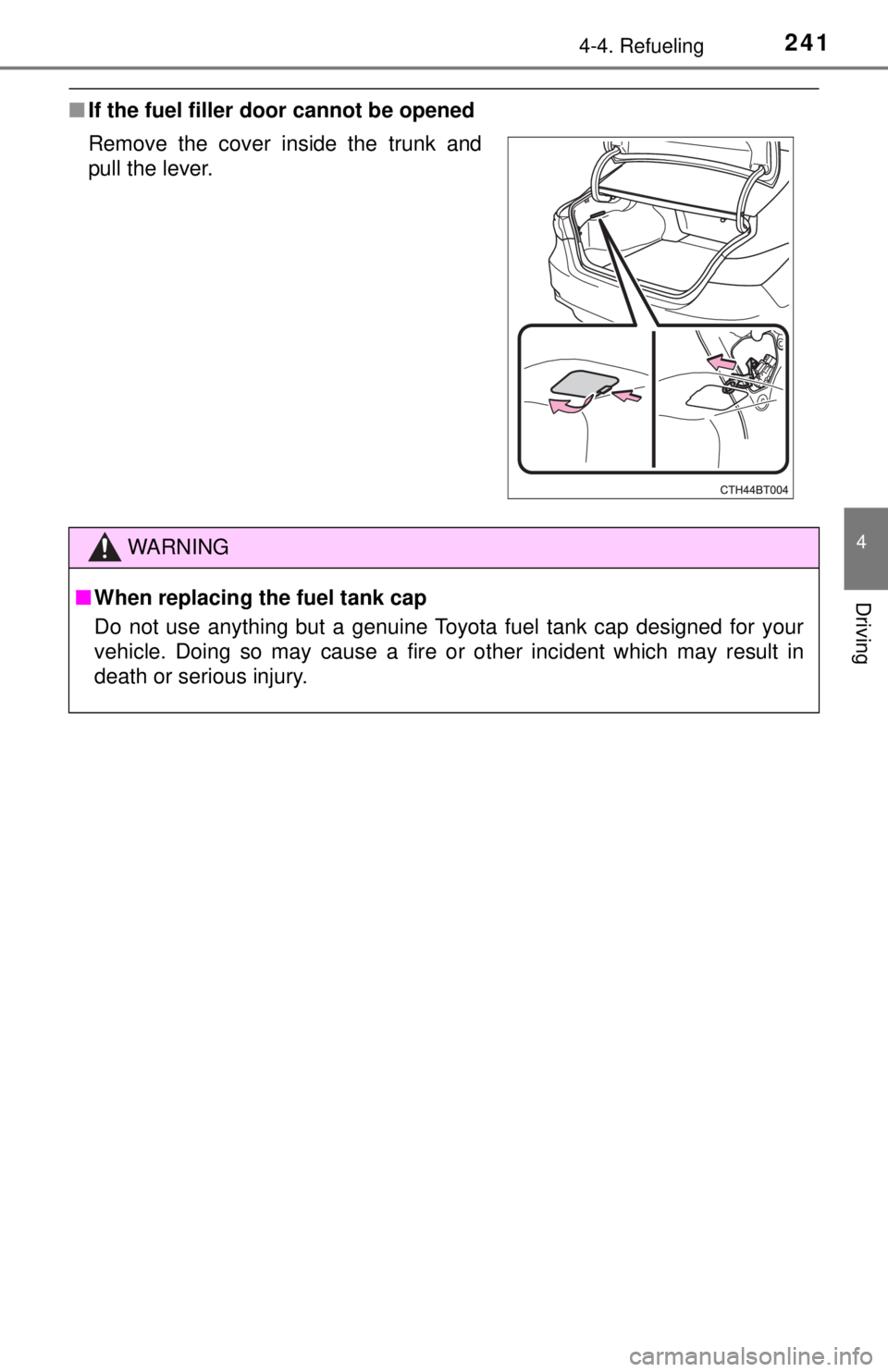
2414-4. Refueling
4
Driving
■If the fuel filler door cannot be opened
Remove the cover inside the trunk and
pull the lever.
WARNING
■ When replacing the fuel tank cap
Do not use anything but a genuine Toyota fuel tank cap designed for your
vehicle. Doing so may cause a fire or other incident which may result in
death or serious injury.
Page 351 of 596

3515-1. Using the air conditioning system and defogger
5
Interior features
■When the outside temperature exceeds 75°F (24°C) and the air condition-
ing system is on
● In order to reduce the air conditioning power consumption, the air condition-
ing system may switch to recirculated air mode automatically. This may also
reduce fuel consumption.
● Recirculated air mode is selected as a default mode when the power switch
is turned to ON mode.
● It is possible to switch to outside air mode at any time by pressing .
■ When the outside temperature is low
The dehumidification function may not operate even when is pressed.
■ Operation of the air conditio ning system in Eco drive mode
● In the Eco drive mode, “ECO” is displayed on the air conditioning screen
and the air conditioning system is controlled as follows to prioritize fuel effi-
ciency:
• Engine speed and compressor operation controlled to restrict heating/
cooling capacity
• Fan speed restricted when automatic mode is selected
● To improve air conditioning performance, perform the following operations:
• Adjust the fan speed
• Turn off Eco drive mode
■ Ventilation and air conditioning odors
●To let fresh air in, set the air conditioning system to the outside air m\
ode.
● During use, various odors from inside and outside the vehicle may enter into
and accumulate in the air conditioning system. This may then cause odor to
be emitted from the vents.
● To reduce potential odors from occurring:
• It is recommended that the air conditioning system be set to outside air
mode prior to turning the vehicle off.
• The start timing of the blower may be delayed for a short period of time
immediately after the air conditioning system is started in automatic
mode.
■ Air conditioning filter
→P. 448
■ Customization
Some functions can be customized. ( →P. 557)
Page 411 of 596
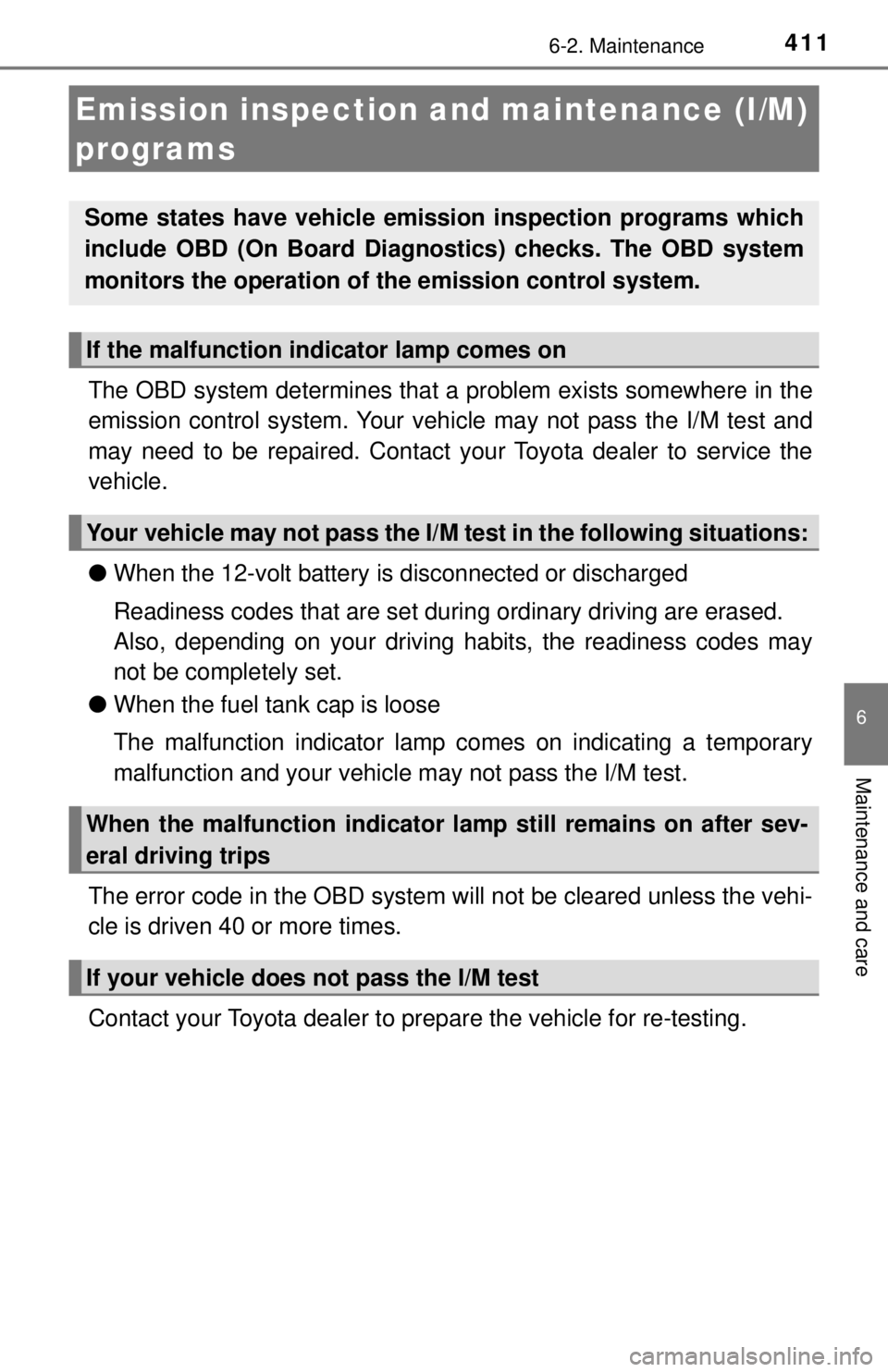
4116-2. Maintenance
6
Maintenance and care
The OBD system determines that a problem exists somewhere in the
emission control system. Your vehi cle may not pass the I/M test and
may need to be repaired. Contact your Toyota dealer to service the
vehicle.
● When the 12-volt battery is disconnected or discharged
Readiness codes that are set duri ng ordinary driving are erased.
Also, depending on your driving habits, the readiness codes may
not be completely set.
● When the fuel tank cap is loose
The malfunction indicator lamp comes on indicating a temporary
malfunction and your vehicle may not pass the I/M test.
The error code in the OBD system will not be cleared unless the vehi-
cle is driven 40 or more times.
Contact your Toyota dealer to prepare the vehicle for re-testing.
Emission inspection an d maintenance (I/M)
programs
Some states have vehicle emission inspection programs which
include OBD (On Board Diagnos tics) checks. The OBD system
monitors the operation of the emission control system.
If the malfunction indicator lamp comes on
Your vehicle may not pass the I/M test in the following situations:
When the malfunction indicator la mp still remains on after sev-
eral driving trips
If your vehicle does not pass the I/M test